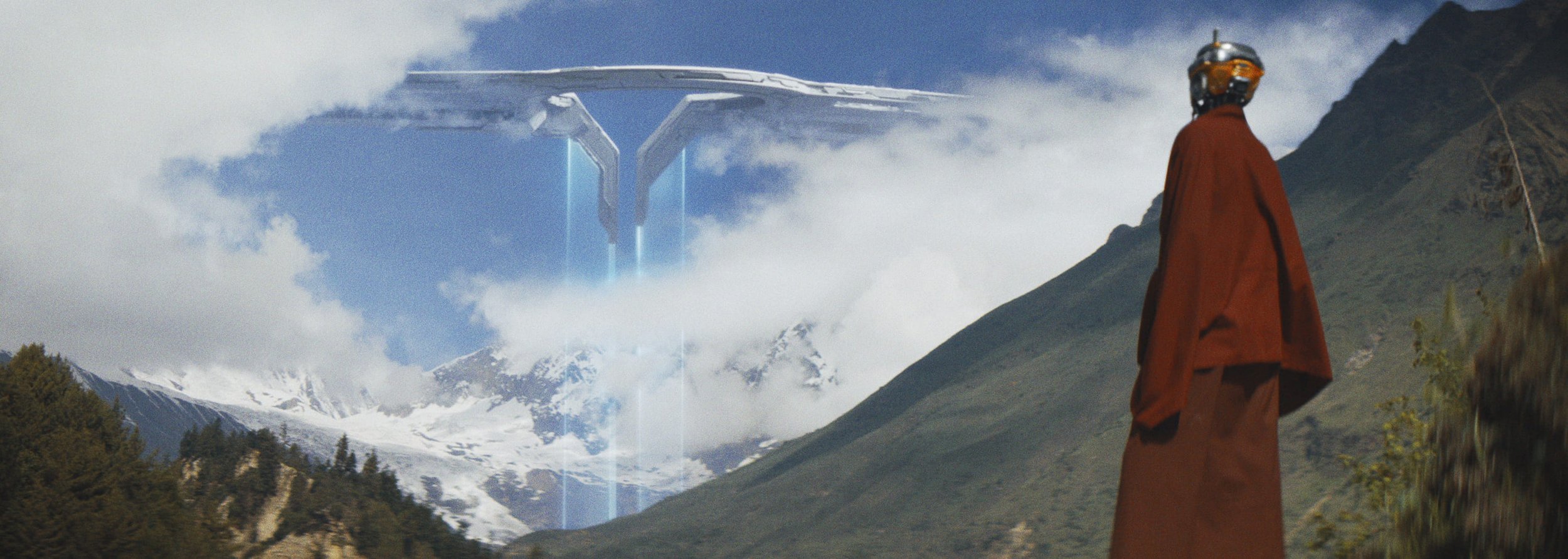
Let the great mind spin
GARETH EDWARDS’ THE CREATOR (2023)
OCTOBER 2, 2023
Machines who raise children, mourn each others’ passings and embark on a human-like quest for freedom ask us to question what is artificial in The Creator.
Sure, we’ve seen it before. We’ve seen beautifully angled buildings of the future, surfaces sheer and dark, defying gravity to edge up out of our flat horizon, in Blade Runner (1982); but here they are add-ons to our modern skyscrapers, suggesting a bridge from our world to the future. We’ve seen transport vehicles glide blissfully at a gracefully short height above the Earth, with the landspeeders in Star Wars (1977); but this time they are boat-like vessels, floating on air instead of the water just underneath, with “simulants” resting their arms in the breeze on the side. And we have seen ruggedly beautiful landscapes paired with gothic behemoth ships, in the Dune (2021), but here it is a tank to end all tanks, crushing lush green growth and emitting deafening metallic clangs, with a corporate looking, creepily simple “us army” branding on light blue paint that belies its annihilistic aims.
And, goodness, have we seen robots. Since the clunky tin men of Metropolis (1927), to the dome-headed giants of Forbidden Planet (1956), to the one-note killer in Robocop (1987), to the “but he’s got a great personality” charmer WALL-E (2008), and many in between – it is a dire challenge for filmmakers to depict robots (or replicants, or in this case, simulants – and yet, here we are, in 2023, viewing the imagination of the industry still at work, as we peer through pleasantly whirring cylinders of metal located where the elegantly titled “mastoid portion” of the human head should exist (behind the ears).
In recent times, HBO’s Westworld (2016-2022) came close to recognizing the full technical breadth of A.I. – control not only of physical hardware but wireless systems, and the omnipresent connection machines would undoubtedly have given how connected the world already is (and will yet become, thanks to the X man himself, Elon Musk, and his impending Starlink system – eerily reminiscent of “Skynet”, the satellite system in The Terminator series). In the future Edwards has conjured, the focus remains more down to Earth, namely in the machine realm. (Questions regarding why this A.I. cannot simply infect and control NOMAD, the skybound, colossal, eagle-like space ship that cost the US $10 trillion and is its “last hope” against the machine, go unanswered.) This is primarily a hardware story, about the potential for a highly permeable boundary between us and them. (You thought robots could never be monks? Think again.)
The feats of The Creator extend beyond its visual beauty, which Edwards showed with the ethereal flare smoke in his take on Godzilla (2014), or the tall grass bending to a ship’s descent in Rogue One: A Star Wars Story (2016), popularly considered of a higher grade than some (many?) of its predecessors in the franchise. It also attempts to smuggle in a romantic drama, a surrogate child and the couple who creates and raises her. As our protagonist (traveling across only space, not time, this time), John David Washington seems to be still finding his footing in drama; fully believable as a soldier, he musters tears and teeth (we finally see him smile on screen, gazing at a digital Polaroid of sorts), but we feel the work it warrants from him. Just like Dad, he’s a star, but hasn’t arrived yet. (Breathing life into Malcom X and Macbeth in one lifetime, not to mention an equalizing angel of death, and over 40 other roles, takes time.)
Something to appreciate further is the lightness of Edwards’ hand with tempting treats; in another director’s hands, we’d have seen the annihilation of LA relished. Slow motion shots of the Bank of America tower crumbling; the Hollywood sign aflame. Here, it is mere backstory. We also could have seen the obliterating power of the ultimate A.I. “weapon” smacked across the screen, but instead it’s used in modest ways, and sparingly. And as far as campy U.S. military villains gone mad go – the tiresome Colonel Quaritch in Avatar (2009) has us covered. Here we get a scarred but focused colonel brought to life by the capable, if confusingly cast, Allison Janney.
And yet, it’s hard to buy everything the film is selling. Are record players really de riguer in beach houses in the southeast Asia of the future? Are there no robot writers, about whom the WGA recently waved a flag? But Edwards and the team, powered by the venerable ILM, are iterating in visually striking and emotionally earnest ways, urging us to revisit the foregone conclusion that machines will be our doom. Rightly, and presciently, it reminds us that the most likely cause of the end of us – is us.